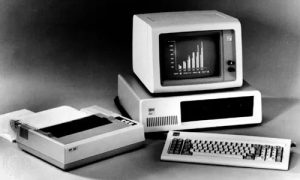The history of computers is a captivating tale of human ingenuity, where each epoch marked a remarkable leap forward in technology. From the rudimentary mechanical devices of the 17th century to the sleek and powerful machines of today, computing has undergone a relentless evolution. This article sheds light on the significant milestones of this fascinating journey, highlighting the key innovations that have shaped the world of technology as we know it.
1. The Birth of Mechanical Computing (17th – 19th centuries):

The inception of the computer age can be traced back to the 17th century when the concept of mechanical computing first emerged. Mathematicians like Blaise Pascal and Gottfried Wilhelm Leibniz designed calculating machines that used gears and levers to perform basic arithmetic operations. However, the true pioneer in this era was Charles Babbage, who envisioned the “Analytical Engine” in the 19th century. Though never fully realized during his lifetime, Babbage’s design laid the foundation for future computers with its programmable nature.
2. The Advent of Electromechanical Computers (1930s – 1940s):

The 20th century brought a paradigm shift in computing with the development of electromechanical computers. Pioneering efforts by Konrad Zuse in Germany and George Stibitz in the United States resulted in the creation of the first programmable electromechanical machines. However, it was the colossal ENIAC (Electronic Numerical Integrator and Computer) that took center stage during World War II. Built by John W. Mauchly and J. Presper Eckert, the ENIAC was a massive machine, occupying an entire room, and revolutionized computation with its speed and versatility.
3. The Era of Vacuum Tubes and Transistors (1950s – 1960s):

The post-war period witnessed a monumental shift towards electronic computing. The introduction of vacuum tubes enabled computers to become more compact and faster. UNIVAC I, the first commercially available computer, was one of the earliest to incorporate these tubes. However, the bulky and power-hungry vacuum tubes were soon succeeded by the invention of the transistor by Bell Laboratories in 1947. Transistors offered enhanced reliability, efficiency, and speed, leading to the development of computers like the IBM 7090 and the CDC 1604.
4. The Dawn of Integrated Circuits (1960s – 1970s):

The 1960s ushered in the era of integrated circuits (ICs), a revolutionary breakthrough that further miniaturized computers. Created by Jack Kilby and Robert Noyce, ICs combined multiple transistors and other components on a single chip, paving the way for the emergence of mainframe computers and minicomputers. Companies like IBM, DEC, and Hewlett-Packard became prominent players, driving computing accessibility to corporations and research institutions.
5. The Personal Computer Revolution (1970s – 1980s):

The 1970s witnessed a profound shift with the introduction of personal computers (PCs). Companies like Apple, founded by Steve Jobs and Steve Wozniak, and Microsoft, founded by Bill Gates and Paul Allen, brought computing power to the masses. The Apple II and the IBM Personal Computer were among the early popular models that empowered individuals to perform tasks previously reserved for large mainframes. The graphical user interface (GUI) developed by Xerox PARC, later adapted by Apple’s Macintosh and Microsoft Windows, further revolutionized user interaction.
6. The Internet Age (1990s – 2000s):

The late 20th century marked the rise of the internet, a network that interconnected computers worldwide, transforming the way information was accessed and shared. Tim Berners-Lee’s invention of the World Wide Web in 1989 revolutionized online communication. The dot-com bubble of the late 1990s saw an exponential growth of internet-based companies. This era also witnessed a shift from desktop computers to laptops, making computing more portable and convenient.
7. Mobile Computing and the Cloud (2000s – Present):

The 21st century witnessed the proliferation of mobile computing, with smartphones and tablets becoming integral parts of our daily lives. The launch of the iPhone in 2007 revolutionized the smartphone industry, introducing touch-screen interfaces and app ecosystems. Cloud computing emerged as a game-changer, allowing users to store data and access applications remotely. Tech giants like Google, Amazon, and Microsoft led the charge in providing cloud-based services.
From the mechanical marvels of the 17th century to the powerful smartphones in our pockets today, the history of computers represents a breathtaking journey of human innovation. Each phase has contributed to the exponential growth and transformation of computing, bringing about a profound impact on society, communication, and business. As we look to the future, we can only marvel at the continued evolution of computing technology and the limitless possibilities it holds for our interconnected world.



